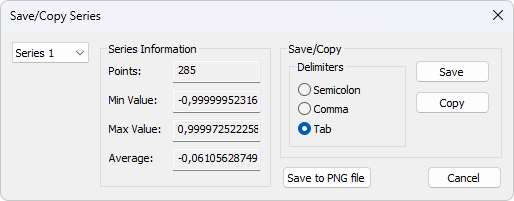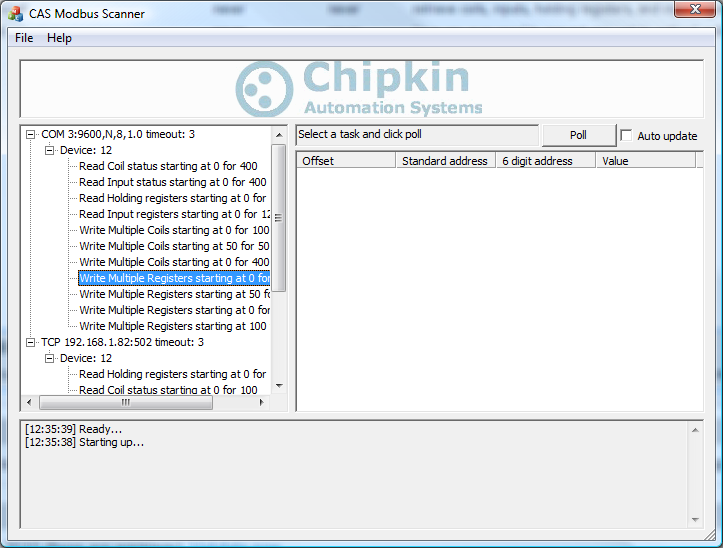
- #Modbus poll 6 serial
- #Modbus poll 6 full
- #Modbus poll 6 trial
For the second response item, specify the offset in bytes relative to the beginning of the array. In the "Data type" field, select a data type for each response item: Decimal 16 bit, Signed. As a result, the values will be named AIN1. Check the "Append counter to name" checkbox. In the "Count" field, enter the number of values: 4. In the "Name" field, enter the base name for each value: ain or aot. In the request properties, specify reading of nine registers, starting from 0003. You need to read the values of analog inputs and outputs according to the following MODBUS register map: In the previous examples, the offset was "-1" the application counted the offset automatically depending on the amount of data in the previous response items.Ĭase 5 (Figure 7). In this case, "8" means skipping four 2-byte registers.  Add a request in the request properties, specify reading of five registers, starting from 8214. In the device’s memory, the values that we need are located at the addresses 82. Otherwise, you’ll have to break your request into two requests for different addresses. If the gap between the two registers in the device’s memory is small enough, you can read the whole range of values in one request, and then select the values that you need from the captured array. You can read about 100 registers at a time via MODBUS. You need to read two registers, but they are not located in the device’s memory one after another: There are other registers (values) between them. One value is 16 bits long and occupies one register the other value is 32 bits long and occupies two registers.Ĭase 4 (Figure 6). Check or uncheck the "Unsigned" checkbox for each value.Ĭase 3 (Figure 5). In the "Data type" field, select a data type for each response item. As a result, the resulting value names will be VALUE1 and VALUE2.
Add a request in the request properties, specify reading of five registers, starting from 8214. In the device’s memory, the values that we need are located at the addresses 82. Otherwise, you’ll have to break your request into two requests for different addresses. If the gap between the two registers in the device’s memory is small enough, you can read the whole range of values in one request, and then select the values that you need from the captured array. You can read about 100 registers at a time via MODBUS. You need to read two registers, but they are not located in the device’s memory one after another: There are other registers (values) between them. One value is 16 bits long and occupies one register the other value is 32 bits long and occupies two registers.Ĭase 4 (Figure 6). Check or uncheck the "Unsigned" checkbox for each value.Ĭase 3 (Figure 5). In the "Data type" field, select a data type for each response item. As a result, the resulting value names will be VALUE1 and VALUE2. #Modbus poll 6 full
Uncheck the "Append counter to name" checkbox, because full names have been defined via the "Name" field.In the "Count" field, enter the number of values: 1.In the "Name" field, enter the base name for each value: VALUE1 or VALUE2.Add two response items: Select "Response items" in the tree and click "Actions → Add response item.".

Each register holds 16 bits, but of a different data type (signed and unsigned).
If the value is unsigned, check the "Unsigned" checkbox.Ĭase 2 (Figure 4). In the "Data type" field, select the data type depending on the number of data bits. As a result, the values will be named VALUE1 and VALUE2.  Check the "Append counter to name" checkbox: The application will automatically add the index number (1 or 2) to the base name. In the "Count" field, enter the number of values: 2. In the "Name" field, enter the base name for each value: VALUE. Each value consists of two bytes (2 * 8 = 16 bits). The meaning of these bytes depends on the MODBUS device’s firmware version and register map.Ĭase 1 (Figure 3). In the example, four bytes will be read, starting from the address 8214. Each register contains two bytes (16 bits) of data. For example, in the example shown in Figure 3, two registers located at the address 8214 are read. Otherwise, the application will be unable to disassemble MODBUS packets. Please note that you must define response items for the device and format of these items.
Check the "Append counter to name" checkbox: The application will automatically add the index number (1 or 2) to the base name. In the "Count" field, enter the number of values: 2. In the "Name" field, enter the base name for each value: VALUE. Each value consists of two bytes (2 * 8 = 16 bits). The meaning of these bytes depends on the MODBUS device’s firmware version and register map.Ĭase 1 (Figure 3). In the example, four bytes will be read, starting from the address 8214. Each register contains two bytes (16 bits) of data. For example, in the example shown in Figure 3, two registers located at the address 8214 are read. Otherwise, the application will be unable to disassemble MODBUS packets. Please note that you must define response items for the device and format of these items. #Modbus poll 6 serial
For more information on request options, see the Help for the module (Start → Programs → Advanced Serial Data Logger → Help). You can grasp the meaning of request options from their names. When a window opens (Figure 3), click "Action → Add new request" to add one or more requests. On the "Query Parse Filter" tab, select that module and click the "Setup" button to the right of the module name in the list.įigure 2: Selecting the data query and parser module

To configure the polling, use the MODBUS RTU module in ASDL (Figure 2). When polling a MODBUS device and capturing data, the computer is the "master," and the device is the "slave." It means that the application running on the computer sends MODBUS requests, and the device replies to them. If that is the case, check the "RS485 interface mode" checkbox.įigure 1: Connection settings Configuring the polling via MODBUS MODBUS devices are usually connected to the computer via the RS485 interface, with a special converter.
You know the connection settings for the devices (baud rate, number of data bits, and so on).Ĭonfigure the connection (Figure 1). You know the register addresses where the values that you need are stored. You have already worked with MODBUS devices. The MODBUS RTU module for the data logger. #Modbus poll 6 trial
Advanced TCP/IP Data Logger Professional, Enterprise, or a trial version. MODBUS polling for two MODBUS devices and log the data received to the database. MODBUS RTU polling: Configuring master station.








 0 kommentar(er)
0 kommentar(er)
